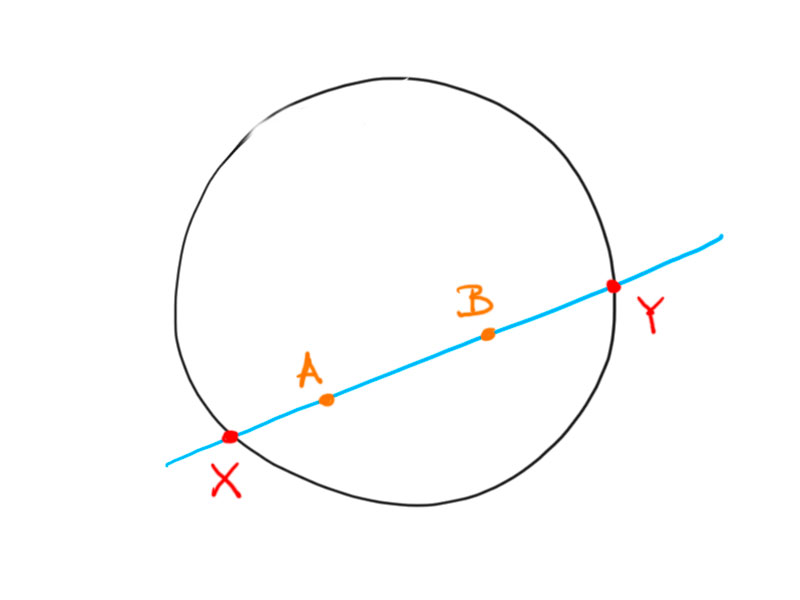Theorem. The shortest piecewise continously differentiable curve in $H^n$ connecting two points $p$ and $q$ is the hyperbolic line segment between them. It’s length is $$d(p,q) = arcosh(-\langle p,q\rangle).$$
Proof. We have to show that for an arbitrary cuve $\gamma: [a,b] \to H^n$, with $\gamma(a) = p$ and $\gamma(b) = q$ we have:
\[
\mathrm{length}(\gamma) = \int_a^b \sqrt{\langle\gamma'(t),\gamma'(t)\rangle} dt \ge d(p,q),
\]
with equality if and only if $\gamma$ is the hyperbolic line segment. Let
\[
f(x) = arcosh(-\langle p,x \rangle).
\]
Then the gradient of $f$ is given by
\[
\grad_x f = -\frac{1}{\sqrt{\langle p,x \rangle^2 – 1}}p
\]
We are only interested in the part of the gradient that is in the tangent space of $H^n$. So we project the gradient onto the tangent space at $x$ and obtain
\begin{align*}
\pi_\grad(x) &= \grad_x f – \frac{\langle grad_x f, x\rangle}{\langle x, x\rangle} x \\
& = \grad_x f + \langle \grad_x f, x \rangle x \\
& = -\frac{1}{\sqrt{\langle p,x \rangle^2 – 1}}( p -\langle p,x \rangle x ).
\end{align*}
Observe that the projected gradient is always in the plane spanned by $p$ and $x$ and it points “away” from $p$. A simple calculation shows that $\langle \pi_\grad(x), \pi_\grad(x) \rangle = 1$. Then using the fundamental theorem of calculus and the chain rule we obtain
\begin{align*}
d(p,q)
&= f(q) – f(p) \\
&= \int_a^b \langle \grad_{\gamma(t)} f, \gamma'(t) \rangle dt \\
&= \int_a^b \langle \pi_\grad(\gamma(t)), \gamma'(t) \rangle dt & \text{the part in $x^\perp$ does not matter!} \\
& \le \int_a^b \underbrace{\| \pi_\grad(\gamma(t)) \|}_{=1} \| \gamma'(t)\| dt & \text{Cauchy-Schwarz inequality} \\
& = \mathrm{length}(\gamma).
\end{align*}
Equality in the Cauchy-Schwarz inequality holds if and only if the tangent vector $\gamma’$ and the projected gradient are parallel. With the above observation on the projected gradient we obtain equality if and only if the curve is exactly the hyperbolic line segment.
$\Box$
Remark. Hyperbolic lines can be considered analogs of straight lines in Euclidean space. They obviously violate Euclid’s parallel axiom, since for a given line and a point not on the line there exist many hyperbolic lines through the point not intersecting the line.
Projective model of $H^n$
We derive a projective model of hyperbolic space in the following way:
\begin{align*}
\sigma : H^n& \to H_\pr^n = \{ [x] \in \RP^n \mid \langle x,x \rangle_{n,1} < 0 \} \\
p& \mapsto [p].
\end{align*}
This map is a bijection and we can define a metric on $H_\pr^n$ from the metric in $H^n$ that turns $\sigma$ into an isometry:
\[
\cosh d_\pr([x],[y]) = \frac{|\langle x,y \rangle|}{\sqrt{\langle x,x \rangle \langle y,y \rangle}}.
\]
If we normalize the vectors $x \in \R^{n,1}$ with $\sprod{x,x} = 0$ such that $x_{n+1} = 1$, then we obtain
\[
\sprod{\rvector{u\\1},\rvector{u\\1}} = 0 \Leftrightarrow \underbrace{(u,u)}_{\text{Eucl. scalar product}} = 1.
\]
So the affine image of the quadric $Q = \{ [x] \in \R^{n,1} \mid \sprod{x,x}_{n,1} = 0 \}$ is the unit sphere $S^{n-1} = \{ u \in \R^n \mid (u,u) = 1 \}$. The points in $H^n$ resp. $H^n_\pr$ are then naturally identified with the inside of the unit sphere:
\[
D = \{ u \in \R^n \mid (u,u) < 1 \}.
\]
If $\sprod{x,x} < 0$ then $x_{n+1} \neq 0$. So we can normalize the representatives and define a map from the projective model of hyperbolic space to the open ball $D$
\[
H_\pr^n \ni [\rvector{x\\x_{n+1}}] = [\rvector{u\\1}] \longmapsto
u \in \R^n \text{ with } (u,u) < 1.
\]
This is a bijective map and can be turned into an isometry by defining the following metric on the open ball:
\[
\cosh d_\mathrm{K}(u,v)
= \frac{1 – (u,v)}{\sqrt{(1-(u,u))(1-(v,v))}}
= \cosh d_\pr([\rvector{u\\1}],[\rvector{v\\1}]).
\]
Summing up until now we have three isometric models for hyperbolic space
\[
\underbrace{(H^n,d)}_{\text{hyperboloid model}}
\;\longleftrightarrow\; \underbrace{(H_\pr^n, d_\pr)}_{\text{projective model}}
\;\longleftrightarrow\; \underbrace{(D,d_\mathrm{K})}_{\text{Klein (disc) model}}
\]
Definition. A projective transformation $f: \RP^n \to \RP^n$ $(n > 1)$ with $f(Q) = Q$, where $Q = \{ [x] \in \RP^n \mid \sprod{x,x}_{n,1} = 0\}$ is a hyperbolic motion.
Theorem. Hyperbolic motions are isometries of $H^n_\pr$, i.e. they preserve the distances
\[
d_\pr([x],[y]) = d_\pr(f([x]),f([y]))\text{, for all $[x], [y] \in H^n_\pr$.}
\]
They build the group $\mathrm{PO}(n,1) = \mathrm{O}(n,1)/\{\pm Id\}$.
Proof. The signature of the scalar product is not neutral for $n > 1$ so we can use the theorem relating the preservation of the quadric with orthogonal transformations. So the hyperbolic motions are induced by orthogonal transformations which form the group $\mathrm{O}(n,1)$. Further these transformations map hyperbolic space to hyperbolic space, since they preserve the entire bilinear form and in particular its sign. As the metric is defined via the scalar product (bilinear form) the hyperbolic motions are isometries.
$\Box$
Theorem. For two points $A, B \in H_\pr^n$ let $X$ and $Y$ be two points where the line $AB$ intersects the quadric $Q$ as in the picture below (i.e. $\{A,Y\}$ seperate $\{B,X\}$). Then
\[
d_\pr(A,B) = \frac{1}{2} \log \cr (B,X,A,Y).
\]


